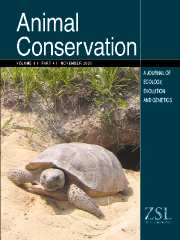Crossref Citations
This article has been cited by the following publications. This list is generated based on data provided by
Crossref.
Garza, J. C.
and
Williamson, E. G.
2001.
Detection of reduction in population size using data from microsatellite loci.
Molecular Ecology,
Vol. 10,
Issue. 2,
p.
305.
Eldridge, Mark D. B.
Browning, Teena L.
and
Close, Robert L.
2001.
Provenance of a New Zealand brush‐tailed rock‐wallaby (Petrogale penicillata) population determined by mitochondrial DNA sequence analysis.
Molecular Ecology,
Vol. 10,
Issue. 10,
p.
2561.
Stow, A. J.
Sunnucks, P.
Briscoe, D. A.
and
Gardner, M. G.
2001.
The impact of habitat fragmentation on dispersal of Cunningham’s skink (Egernia cunninghami): evidence from allelic and genotypic analyses of microsatellites.
Molecular Ecology,
Vol. 10,
Issue. 4,
p.
867.
Goossens, Benoît
Funk, Stephan M.
Vidal, Carmen
Latour, Stéphanie
Jamart, Aliette
Ancrenaz, Marc
Wickings, Elisabeth J.
Tutin, Caroline E. G.
and
Bruford, Michael W.
2002.
Measuring genetic diversity in translocation programmes: principles and application to a chimpanzee release project.
Animal Conservation,
Vol. 5,
Issue. 3,
p.
225.
Larsson, Jobs Karl
Sun, Yue‐Hua
Fang, Yun
Segelbacher, Gernot
and
Höglund, Jacob
2003.
Microsatellite variation in a Chinese grouse Bonasa sewerzowi population: signs of genetic impoverishment?.
Wildlife Biology,
Vol. 9,
Issue. 4,
p.
261.
Thévenon, Sophie
Bonnet, Amélie
Claro, Françoise
and
Maillard, Jean‐Charles
2003.
Genetic diversity analysis of captive populations: The Vietnamese sika deer (Cervus nippon pseudaxis) in zoological parks.
Zoo Biology,
Vol. 22,
Issue. 5,
p.
465.
Robert, Alexandre
Couvet, Denis
and
Sarrazin, François
2003.
The role of local adaptation in metapopulation restorations.
Animal Conservation,
Vol. 6,
Issue. 3,
p.
255.
Markert, J A
Grant, P R
Grant, B R
Keller, L F
Coombs, J L
and
Petren, K
2004.
Neutral locus heterozygosity, inbreeding, and survival in Darwin's ground finches (Geospiza fortis and G. scandens).
Heredity,
Vol. 92,
Issue. 4,
p.
306.
Dannewitz, Johan
Petersson, Erik
Dahl, Jonas
Prestegaard, Tore
Löf, Anna‐Carin
and
Järvi, Torbjörn
2004.
Reproductive success of hatchery‐produced and wild‐born brown trout in an experimental stream.
Journal of Applied Ecology,
Vol. 41,
Issue. 2,
p.
355.
Spielman, Derek
Brook, Barry W.
and
Frankham, Richard
2004.
Most species are not driven to extinction before genetic factors impact them.
Proceedings of the National Academy of Sciences,
Vol. 101,
Issue. 42,
p.
15261.
Rauch, Erik M.
and
Bar-Yam, Yaneer
2004.
Theory predicts the uneven distribution of genetic diversity within species.
Nature,
Vol. 431,
Issue. 7007,
p.
449.
Frankham, Richard
2005.
Genetics and extinction.
Biological Conservation,
Vol. 126,
Issue. 2,
p.
131.
Rauch, Erik M.
and
Bar-Yam, Yaneer
2005.
Estimating the total genetic diversity of a spatial field population from a sample and implications of its dependence on habitat area.
Proceedings of the National Academy of Sciences,
Vol. 102,
Issue. 28,
p.
9826.
Swindell, William R.
and
Bouzat, Juan L.
2005.
MODELING THE ADAPTIVE POTENTIAL OF ISOLATED POPULATIONS: EXPERIMENTAL SIMULATIONS USING DROSOPHILA.
Evolution,
Vol. 59,
Issue. 10,
p.
2159.
FRANKHAM, R.
2005.
Stress and adaptation in conservation genetics.
Journal of Evolutionary Biology,
Vol. 18,
Issue. 4,
p.
750.
Swindell, William R.
and
Bouzat, Juan L.
2005.
MODELING THE ADAPTIVE POTENTIAL OF ISOLATED POPULATIONS: EXPERIMENTAL SIMULATIONS USING DROSOPHILA.
Evolution,
Vol. 59,
Issue. 10,
p.
2159.
Briskie, James V.
2006.
INTRODUCED BIRDS AS MODEL SYSTEMS FOR THE CONSERVATION OF ENDANGERED NATIVE BIRDS.
The Auk,
Vol. 123,
Issue. 4,
p.
949.
Briskie, James V.
2006.
INTRODUCED BIRDS AS MODEL SYSTEMS FOR THE CONSERVATION OF ENDANGERED NATIVE BIRDS.
The Auk,
Vol. 123,
Issue. 4,
p.
949.
Artamonova, V. S.
and
Makhrov, A. A.
2006.
Unintentional genetic processes in artificially maintained populations: Proving the leading role of selection in evolution.
Russian Journal of Genetics,
Vol. 42,
Issue. 3,
p.
234.
FERREIRA, ÁLVARO G. A.
and
AMOS, WILLIAM
2006.
Inbreeding depression and multiple regions showing heterozygote advantage in Drosophila melanogaster exposed to stress.
Molecular Ecology,
Vol. 15,
Issue. 13,
p.
3885.


